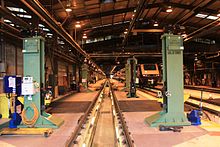
Bristol Temple Meads is the oldest and largest railway station in Bristol, England. It is located 118 miles 31 chains away from London Paddington. It is an important transport hub for public transport in the city; there are bus services to many parts of the city and surrounding districts, with a ferry to the city centre. Bristol's other major station, Bristol Parkway, is a more recent station on the northern outskirts of the conurbation.

The Bristol Harbour Railway was a standard-gauge industrial railway that served the wharves and docks of Bristol, England. The line, which had a network of approximately 5 mi (8.0 km) of track, connected the Floating Harbour to the GWR mainline at Bristol Temple Meads. Freight could be transported directly by waggons to Paddington Station in London. The railway officially closed in 1964.

The Barry Tourist Railway is a railway developed to attract visitors to Barry in the Vale of Glamorgan, South Wales. It is a key element of the Barry Rail Centre which also includes engineering and training facilities.

Newton Abbot railway station serves the market town of Newton Abbot in Devon, England. It is 214 miles 5 chains (345 km) from London Paddington. The station today is managed by Great Western Railway, who provide train services along with CrossCountry.

Salisbury railway station serves the city of Salisbury in Wiltshire, England. It is 83 miles 43 chains (134.4 km) from London Waterloo on the West of England line to Exeter St Davids. This is crossed by the Wessex Main Line from Bristol Temple Meads to Southampton Central. The station is operated and served by South Western Railway (SWR), and is also served by Great Western Railway (GWR).

St Blazey engine shed is located in Par, Cornwall, United Kingdom, although it is named after the adjacent village of St Blazey. It was built in 1874 as the headquarters of the Cornwall Minerals Railway but for many years was a depot of the Great Western Railway. The current depot operator is DB Cargo and the depot TOPS code is BZ.

Birkenhead Mollington Street was a former traction maintenance depot located at Mollington Street in Birkenhead, England, on the Birkenhead Dock Branch railway. Although never directly connected by rail, the depot was situated less than 200 m (660 ft) from Birkenhead Central railway station. The depot serviced steam and subsequently diesel locomotives until 1985, when it was closed and demolished. As of 2018, the site of the depot is still disused.

Old Oak Common TMD was a traction maintenance depot located west of London Paddington, in Old Oak Common. The depot codes were OC for the diesel depot and OO for the carriage shed. In steam days the shed code was 81A.

Bristol Bath Road depot was a railway traction maintenance depot in central Bristol, England, which was in use from 1852 until 1995.

Laira Traction and Rolling Stock Maintenance Depot is a railway traction maintenance depot situated in Plymouth, Devon, England. The depot is operated by Great Western Railway (GWR) and is where their fleet of High Speed Trains are overhauled along with those belonging to CrossCountry. These will be withdrawn in 2023 but it will then become the principal depot for GWR's Class 802 InterCity Express Trains. Other trains visit for daily servicing.
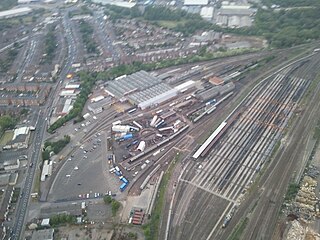
Tyseley TMD is a railway traction maintenance depot situated in Tyseley, Birmingham, England.
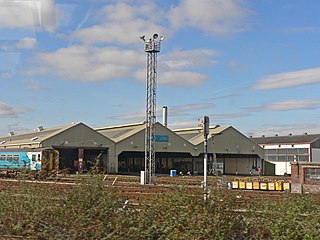
Cardiff Canton TMD is a diesel locomotive traction maintenance depot in Cardiff, Wales. Its depot code is CF. It is operated by Transport for Wales. The depot is used by Transport for Wales fleet and some Cross Country Class 170s.

Neville Hill is a railway train maintenance depot in Osmondthorpe, Leeds, England on the Leeds to Selby Line. The depot is situated 2 miles 14 chains (3.5 km) to the east of Leeds railway station on the north side of the line.

Penzance TMD, also known as Long Rock TMD, is a railway traction maintenance depot situated in the village of Long Rock east of Penzance, Cornwall, England, and is the most westerly and southerly rail depot in the country. The depot operator is Great Western Railway. The depot code is PZ.
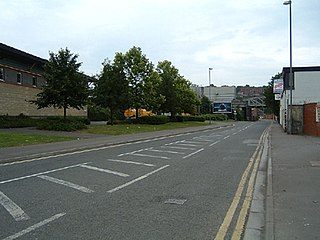
St Philip's Marsh is an industrial inner suburb of Bristol, England. It is bounded by River Avon and Harbour feeder canal making it an almost island area, unlike the other two areas surrounded by water, it was historically part of Gloucestershire and is part of North Bristol. The site is home of Avonmeads Retail Park, a large retail and leisure park with Showcase Cinemas and a Hollywood Bowl ten-pin bowling centre among its tenants. It was extensively redeveloped in the 15 years to 2007.

Exeter Traction Maintenance Depot is a railway Traction Maintenance Depot situated in Exeter, Devon, United Kingdom and is next to the city's main St Davids station. The depot is operated by Great Western Railway and has an allocation of diesel multiple units.

Southall Railway Centre is a non-publicised railway heritage centre at Southall in west London, near Southall railway station and the Grand Union Canal. Formerly of the Great Western Railway, the site is now run partly by Locomotive Services and West Coast Railways, both of whom lease the site from Network Rail. The location is not open to the public.

Salisbury TMD is the South Western Railway traction maintenance depot in Salisbury, Wiltshire, England, situated on the north side of Salisbury railway station. It opened in 1992 to maintain the fleet of DMUs used on the West of England line.
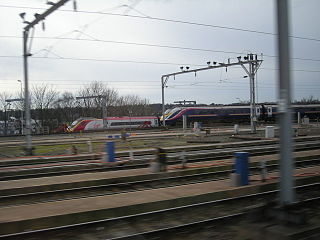
Oxley Traction and Rolling Stock Maintenance Depot is a railway depot located in Wolverhampton, West Midlands, operated by Alstom to maintain Avanti West Coast's British Rail Class 390 Pendolino stock for the West Coast Main Line.

Botanic Gardens TMD is a traction maintenance depot in Kingston upon Hull in Yorkshire, England. As built it was one of the principal steam engine sheds in the Hull area, Botanic Gardens was the one closest to the main Hull Paragon station and its locomotives were responsible for working passenger services in the area. This entry also covers the engine sheds in the Paragon area that preceded Botanic Gardens.
